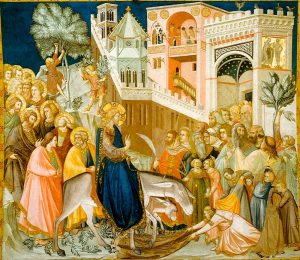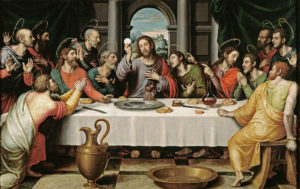Illuminations on the Lectionary readings for April 2, 2023 (Palm / Passion Sunday A)
Liturgy of the Palms A
Gospel: Matthew 21:1-11
We celebrate Palm Sunday and Passion Sunday together as Holy Week begins. In this lectionary year we hear the evangelist Matthew’s account of Jesus’s triumphal procession into Jerusalem.

Christ’s entry into Jerusalem (1320), fresco by Pietro Lorenzetti (1280-1348). Basilica of San Francesco d’Assisi, Assisi, Italy. (Click image to enlarge)
In a variation that we only hear from Matthew, Jesus enters the city apparently riding two animals at once, reflecting the evangelist’s understanding of Zechariah’s prophecy that Israel’s shepherd-king would arrive “mounted on a donkey, and on a colt.” Jesus’s arrival in the city is exciting but tense: A large, noisy crowd surrounds Jesus in a city that Matthew describes as “in a turmoil.” Jesus has warned the disciples that he will be mocked, flogged and crucified. Soon he will anger the authorities again when he drives the money changers out of the temple, as the narrative hurtles toward his passion and death on the cross.
Psalm: Psalm 118:1-2, 19-29
As we enter church on Palm Sunday waving palm fronds – recalling Jesus’ traditional entry into Jerusalem before a cheering crowd – we chant verses from Psalm 118 that portray another festive procession in honor of our Lord and God. In familiar words we celebrate “the day that the Lord has made; let us rejoice and be glad in it!”
Liturgy of the Passion A
First Reading: Isaiah 50:4-9a
When Christians hear Isaiah’s verses about the “suffering servant,” our thoughts naturally turn to Jesus Christ, our messiah and king. After all, our Creeds declare that Jesus suffered for us. Our Gospels reveal a Jesus who taught us to turn our cheeks to those who strike us, knowing that a peaceful response to enemies is no cause for disgrace. During Holy Week, though, it’s important for us to understand that Isaiah was not writing to Christians in a distant future but to a Jewish audience in his own time, a people living in exile in Babylon. They were a suffering body of faithful servants, awaiting a Messiah to guide them home.
Psalm: Psalm 31:9-16
Speaking in tones of lamentation, the Psalmist recites a litany of sorrow, distress, grief, sighing, misery, scorn, horror, dread and more. He suffers, his neighbors scheme; they plot his death. In the poet’s words, “I am forgotten like a dead man, out of mind; I am as useless as a broken pot.” Yet amid all this misery, hope glows like the sun breaking through clouds: Trust in God, place our faith in God’s love, and wait to be saved.
Second Reading: Philippians 2:5-11
Paul sets out these poetic verses from an early Christian hymn, an ancient confession in song that preceded the Apostles’ Creed and Nicene Creed by centuries. In these worshipful words we understand that Christ was fully divine, yet embodied in Jesus he was fully human too. The Son of God willingly set aside his divinity – “emptying himself” – to bear the horrific pain of crucifixion as a vulnerable, frightened human. Jesus took on the full weight of all that suffering to show us the true exaltation of God’s love, calling us only to respond with love for God and our neighbor.
Gospel: Matthew 26:14- 27:66 or Matthew 27:11-54
Sunday’s readings reach their conclusion in Matthew’s long narrative of Jesus’s passion and death. We listen through the long journey from the Last Supper to the crucifixion. There is much packed into these two chapters, from Judas’ betrayal through the institution of the Eucharist; Jesus suffering in the garden, his arrest and trial, his journey to the cross and his death and burial. That’s a lot to grapple with all at once, so let’s reflect on one passage: When Jesus told the apostles during the Last Supper that one of them would betray him, every one of them was afraid. Every one, no matter how much he loved Jesus, wondered if he might be the traitor. Each in turn asked, ‘Surely not I, Lord?” As are we, they are human, frail and weak. And Jesus, loving us still, takes up the cross.
(As an abbreviated alternative, this Gospel may be read in shorter form, including only verses 27:11-54. This portion tells the narrative from the arrest of Jesus to his death on the cross. It ends with a foreshadowing of the resurrection with the opening of the tombs, while a Roman centurion and his soldiers recognize that Jesus was truly God’s Son.)



